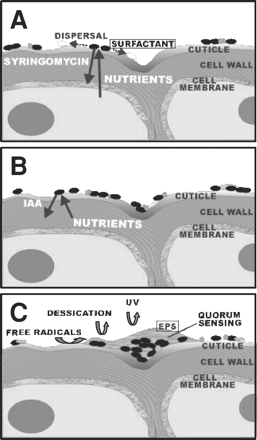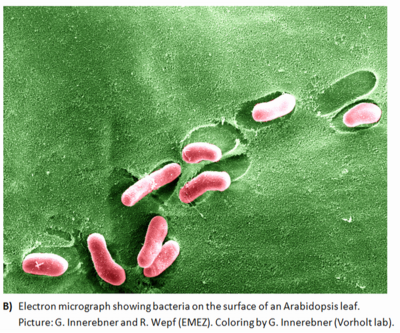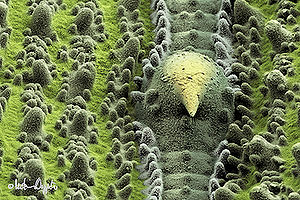Phyllosphere: Difference between revisions
No edit summary |
|||
| Line 16: | Line 16: | ||
The surfaces of most plants are very tortuous at the small scales at which interactions with bacteria will occur. Epidermal cells produce bulges and troughs that will determine the shape and size of low areas on the surface, which in turn will influence the shape and spread of water droplets on the plant (77). The first contact between immigrating bacteria and a leaf normally occurs at the plant cuticle. This waxy layer, which has different three-dimensional crystalline structures on different plant species and can change as leaves age, presumably in part due to microbial modifications, limits passive diffusion of nutrients and water vapor from the plant interior onto the surface and defines the hydrophobicity of the leaf. Thick waxy cuticles have thus been thought to interfere with bacterial colonization of plants by limiting diffusion of nutrients and inhibiting the wetting of the leaf surface. | The surfaces of most plants are very tortuous at the small scales at which interactions with bacteria will occur. Epidermal cells produce bulges and troughs that will determine the shape and size of low areas on the surface, which in turn will influence the shape and spread of water droplets on the plant (77). The first contact between immigrating bacteria and a leaf normally occurs at the plant cuticle. This waxy layer, which has different three-dimensional crystalline structures on different plant species and can change as leaves age, presumably in part due to microbial modifications, limits passive diffusion of nutrients and water vapor from the plant interior onto the surface and defines the hydrophobicity of the leaf. Thick waxy cuticles have thus been thought to interfere with bacterial colonization of plants by limiting diffusion of nutrients and inhibiting the wetting of the leaf surface. | ||
Certain bacteria can increase the wettability of leaves by producing compounds with surfactant properties (16, 43, 86). Bunster et al. (16) found that this ability occurred in 50% of the Pseudomonas strains tested. Because of the hydrophobic nature of the cuticle, it is likely that increased wettability of these habitats allows solubilization and diffusion of substrates, making them more readily available to epiphytic bacteria. Alternatively, biosurfactants may facilitate the movement of bacteria on the phylloplane, as was suggested for tolaasin, a toxin produced by Pseudomonas tolaasi (43). The water film created by the surfactant could spread the bacteria across the leaf surface to areas where nutrients are more abundant. Thus, the production of biosurfactants may be one trait by which bacteria can alter their habitat to exploit it more efficiently. | |||
===Subsection 2=== | ===Subsection 2=== | ||
[[Image:Bio interatcions.gif|thumb|right|350px|"Schematic diagram representing various hypothetical bacterial-habitat modifications in the phyllosphere, such as the release of nutrients from plant cells and bacterial cell dispersal effected by the production of syringomycin, which may act both as a phytotoxin and as a surfactant (A); the release of saccharides from the plant cell wall, caused by bacterial secretion of auxin (B); and protection from environmental stresses via production of EPS in bacterial aggregates(C)"]] | |||
==Microbial processes== | ==Microbial processes== | ||
Revision as of 02:08, 12 April 2010
Introduction
The phyllosphere is a term used in microbiology to refer to leaf surfaces or total above-ground surfaces of a plant as a habitat for microorganisms. All plants are host to numerous and diverse communities of microorganisms including bacteria, fungi, and yeasts. Some are beneficial to the plant, others function as plant pathogens and may damage the host plant or even kill it. However, the majority of bacterial colonists on any given plant have no noticeable effect on plant growth or function.
Research into the characteristics of microbial life in the phyllosphere is of great commercial importance to the agricultural industry for two reasons. First, understanding the survival of plant disease-causing bacteria and fungi is vital for developing new ways to control their spread. Second, there has been a recent rise in the number of food poisoning cases associated with fruit and vegetables contaminated with bacteria such as Salmonella and E. coli O157:H7. This is particularly true of fresh fruits and salads which are not cooked prior to consumption. Preventing these outbreaks by developing better decontamination strategies is important to protect public health.
Physical environment
The leaf surface has long been considered a hostile environment for bacterial colonists. The leaf surface is exposed to rapidly fluctuating temperature and relative humidity, as well as repeated alternation between presence and absence of free moisture due to rain and dew. The leaf also provides limited nutrient resources to bacterial colonists. Such rapid and extreme fluctuations in the physical conditions of above ground plant surfaces yields a hostile microbe environment.
Several factors may influence the microhabitat experienced by bacteria on leaves. First, the leaf itself is surrounded by a very thin laminar layer in which moisture emitted through stomata may be sequestered, thereby alleviating the water stress to which epiphytes are exposed.
Second, some cells in a leaf bacterial population, particularly in plant-pathogenic populations, may not reside in exposed sites on the leaf surface but instead may at least locally invade the interior of the leaf, avoiding the stresses on the exterior of the leaf by residing in substomatal chambers or other interior locations (78, 118). Thus, while some phytopathogens may have the option of avoiding stresses, most other epiphytes apparently must tolerate them in some way.
The surfaces of most plants are very tortuous at the small scales at which interactions with bacteria will occur. Epidermal cells produce bulges and troughs that will determine the shape and size of low areas on the surface, which in turn will influence the shape and spread of water droplets on the plant (77). The first contact between immigrating bacteria and a leaf normally occurs at the plant cuticle. This waxy layer, which has different three-dimensional crystalline structures on different plant species and can change as leaves age, presumably in part due to microbial modifications, limits passive diffusion of nutrients and water vapor from the plant interior onto the surface and defines the hydrophobicity of the leaf. Thick waxy cuticles have thus been thought to interfere with bacterial colonization of plants by limiting diffusion of nutrients and inhibiting the wetting of the leaf surface.
Certain bacteria can increase the wettability of leaves by producing compounds with surfactant properties (16, 43, 86). Bunster et al. (16) found that this ability occurred in 50% of the Pseudomonas strains tested. Because of the hydrophobic nature of the cuticle, it is likely that increased wettability of these habitats allows solubilization and diffusion of substrates, making them more readily available to epiphytic bacteria. Alternatively, biosurfactants may facilitate the movement of bacteria on the phylloplane, as was suggested for tolaasin, a toxin produced by Pseudomonas tolaasi (43). The water film created by the surfactant could spread the bacteria across the leaf surface to areas where nutrients are more abundant. Thus, the production of biosurfactants may be one trait by which bacteria can alter their habitat to exploit it more efficiently.
Subsection 2

Microbial processes
What microbial processes define this environment? Describe microbial processes that are important in this habitat, adding sections/subsections as needed. Look at other topics in MicrobeWiki. Are some of these processes already described? Create links where relevant.
Subsection 1
Subsection 1a
Subsection 1b
Subsection 2
Key Microorganisms
What kind of microbes do we typically find in this environment? Or associated with important processes in this environment? Describe key groups of microbes that we find in this environment, and any special adaptations they may have evolved to survive in this environment. Add sections/subsections as needed. Look at other microbe listings in MicrobeWiki. Are some of the groups of microbes from your environment already described? Create links to those pages. Specific microbial populations will be included in the next section.
Subsection 1
Subsection 1a
Subsection 1b
Subsection 2
Examples of organisms within the group
List examples of specific microbes that represent key groups or are associated with important processes found in this environment. Link to other MicrobeWiki pages where possible.
Current Research
Enter summaries of recent research here--at least three required
References
Edited by student of Angela Kent at the University of Illinois at Urbana-Champaign.


